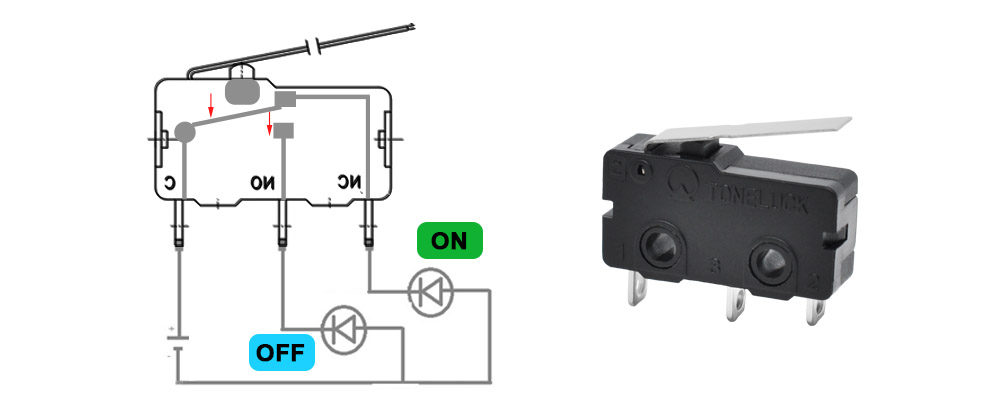The way to wire micro switch may vary depending on the specific switch and the application, but here are some general steps to follow:
The step to wire micro switch
- Determine the type of micro switch you have: There are several types of micro switches, including SPDT (Single-Pole Double-Throw), SPST (Single-Pole Single-Throw), and DPDT (Double-Pole Double-Throw). Make sure you know what type you have before wiring.
- Prepare the wires: Cut and strip the wires you’ll use to connect the switch. Be sure to leave enough wire length to reach the switch and the device you’re connecting it to.
- Identify the terminals: The SPDT micro switches typically have three terminals: common (C), normally closed (NC), and normally open (NO). The common terminal is usually the center terminal, and the NC and NO terminals are on either side.
- Connect the wires: Connect one wire to the common terminal and another wire to either the NC or NO terminal, depending on your application. If you need to use both NC and NO terminals, you’ll need to use a DPDT switch.
- Insulate the connections: Once you’ve connected the wires, you should insulate the connections with electrical tape or heat shrink tubing to prevent accidental shorts.
- Test the switch: Finally, test the switch to make sure it’s working properly. Depending on your application, you may need to adjust the switch position or other settings to get the desired results.

It’s important to note that working with electrical components can be dangerous and should only be done by someone with the proper knowledge and training. If you’re not comfortable working with electricity, it’s best to seek assistance from a qualified professional.
What a micro switch circuit mean?
Micro switches are commonly used in many electrical and mechanical devices as they provide a reliable way to detect physical movements or position changes. There are several types of microswitches with different circuit configurations, including SPDT, SPST NC, SPST NO, DPDT, DPST NO, and DPST NC circuits.
Before wiring a micro switch, you should understand its circuit and here is how you can recognize each type:
SPDT (Single Pole Double Throw)
A SPDT micro switch has three terminals, one common (C) and two switched (NO and NC). When the switch is not activated, the common (C) terminal is connected to the normally closed (NC) terminal, and when the switch is activated, the common (C) terminal is connected to the normally open (NO) terminal.
SPST NC (Single Pole Single Throw Normally Closed)
A SPST NC micro switch has two terminals, one common (C) and one normally closed (NC). When the switch is not activated, the common (C) terminal is connected to the normally closed (NC) terminal, and when the switch is activated, the connection is broken.
SPST NO (Single Pole Single Throw Normally Open)
A SPST NO micro switch has two terminals, one common (C) and one normally open (NO). When the switch is not activated, there is no connection between the common (C) and normally open (NO) terminals, and when the switch is activated, the connection is established.
DPDT (Double Pole Double Throw)
A DPDT micro switch has six terminals, two commons (C1 and C2) and four switched (NO1, NO2, NC1, and NC2). The two poles are independent of each other and operate simultaneously. When the switch is not activated, the common (C1) terminal is connected to the normally closed (NC1) terminal, and the common (C2) terminal is connected to the normally closed (NC2) terminal.
When the switch is activated, the connection is reversed, and the common (C1) terminal is connected to the normally open (NO1) terminal, and the common (C2) terminal is connected to the normally open (NO2) terminal.
DPST NC (Double Pole Single Throw Normally Closed)
A DPST NC micro switch has four terminals, two commons (C1 and C2) and two normally closed (NC1 and NC2). When the switch is not activated, both commons (C1 and C2) are connected to their respective normally closed (NC1 and NC2) terminals, and when the switch is activated, the connection is broken.
DPST NO (Double Pole Single Throw Normally Open)
A DPST NO micro switch has four terminals, two commons (C1 and C2) and two normally open (NO1 and NO2). When the switch is not activated, there is no connection between the commons (C1 and C2) and normally open (NO1 and NO2) terminals, and when the switch is activated, the connection is established.
